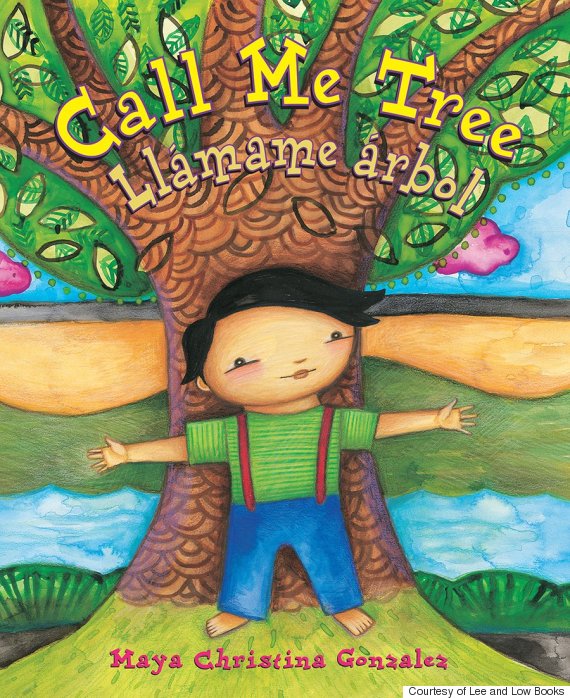What if a children's book contained no gender specific pronouns?
Author Maya Christina Gonzalez explores this idea in her book Call Me Tree, the final book in a trilogy that highlights how valuable our connection to nature can be.
Through Call Me Tree , Gonzalez is pioneering both queer and Chicana representation within children's books in order to provide characters and stories that children can relate to. The Huffington Post chatted with Gonzalez this week about the book and her decision to use no gender specific pronouns.

The Huffington Post: What is the overarching concept for Call Me Tree?
Maya Christina Gonzalez: If I were going to claim an overarching concept, I would say that it’s the culmination of what can happen when we connect with nature personally, relationally and universally. Nature is a perfect resource to help us see through societal projections and feel powerful within ourselves and with each other even when times are rough. Call Me Tree is the final book in a trilogy that I both wrote and illustrated to share with kids just how valuable our connection to nature can be.
The first book, My Colors, My World began because I was haunted by the memory of hot pink desert sunsets when I was a child. I followed the image to uncover how seeing myself reflected in nature was vital when I was young. I realized that not seeing any queer or Chicana representation in children’s books or any media for that matter, left me feeling invisible and irrelevant. But feeling an affinity for the hot pink sky helped give me a sense of self and belonging that I carried with me into adulthood and my coming out.
The second book, I Know the River Loves Me continues the focus on nature, but now it has evolved beyond a sense of self into relationship. I found nature to be my true and constant friend when I was disowned by my family because of their homophobia. The river story rose at a time when I finally felt fully and unconditionally loved and supported in my life. The river actually told me the story! In these first two books, I wanted to share with kids the notion that nature is a constant resource not only to see ourselves, but also to feel held when we need it. We are never alone. No matter what!
Call Me Tree takes it to the next level as the child actually embodies nature. In this book I step out of writing from a personal experience and enter a more universal one. Here everyone is the same and everyone is different. As a tree, a part of nature, the child feels their own strength, individuality and belonging and because of this experience they naturally see it and celebrate it in others. “All trees have roots. All trees belong.”
It was in looking back over the three books that I understood how they fit together and why it was so important to me to share them with kids.
Why did you choose to use no gender-specific pronouns throughout the text?
As a parent, I see the first few years of a child’s life as a time to grow into the fundamentals of who they are. This can include gender identity. Our culture has a powerful trend toward the boy-girl gender binary and conformity comes into play from a child’s earliest possible moment. By being gender free, Call Me Tree provides for some a much needed break from the constant boy-girl assumptions and requirements. It can also provide a moment to pause and consider those assumptions, requirements and their impact.
Despite the fact that there are no gender specific pronouns, reviewers have assumed the main character is a cisgender boy. The main character is actually based on someone assigned girl. The specificity doesn’t matter as much as the opportunity to notice the assumption. Many of us assume a child with short hair, dressed in a t-shirt and pants is a cisgender boy. What does an assumption like that fully communicate? About gender requirements? fitting in? living up to expectations? being accepted? Who does it leave out and what is the impact of being excluded?
Call Me Tree also opens up the possibility that it’s ok not to know the gender of a child. No matter what their gender identity may be, what is valuable is that they feel free, strong, a sense of belonging and appreciative of difference and sameness in themselves and others.
And last, but not least, I chose not to use gender specific pronouns because in my book Gender Now, an educational and activity book for all ages, I explore how ALL of nature reflects multiple levels of gender expression. As a part of nature, so do humans. Because Call Me Tree is about kids embodying nature, open gender identity and expression were built in!
Why is it important that we have children's books that are inclusive of characters outside of a male/female binary?
There are so many reasons why it’s important. I’ll begin with reflection. I know when I was a child and I didn’t see anyone anywhere that looked or felt like me I felt ‘less than,’ like I didn’t matter. It wasn’t something I knew with my mind, it was more of a background ‘fact’ about reality. Working with kids, I’ve become very conscious of what messages they’re surrounded by all the time. They’re absorbing everything to understand the world around them and if there’s no one that looks or feels like them in their books or any other media, it means something. It means something about them and about the world.
With meaning in mind, current research shows that when kids who see images in their books of kids who look like them playing with kids who do not look like them, they are more likely to play with kids who are different than they are. The research goes on to share that it doesn’t have to be reflected in the text to have an effect! This demonstrates the power of children’s books and why it’s important to begin early sharing books like these.
Finally, it’s important because there is truth here. We can learn through nature, history and studying cultures from all over the world and throughout time, that there are more than two ways to identify and express gender. Acknowledging this simple truth, especially as reflected in nature, helps take apart the out dated idea of a binary gender system. Gender nonconformity is one of the leading causes of bullying and can have long lasting, even tragic consequences. By beginning early and sharing age appropriate books that help kids see through gender assumptions, gender creative kids can relax and trust that they are perfectly natural and valuable. And kids who are cisgender can know that they are part of a larger picture of natural diversity. This sets the stage for more learning about diversity and inclusion as they develop and helps dismantle gender based bullying before it begins.
For more information on Call Me Tree, head here.
